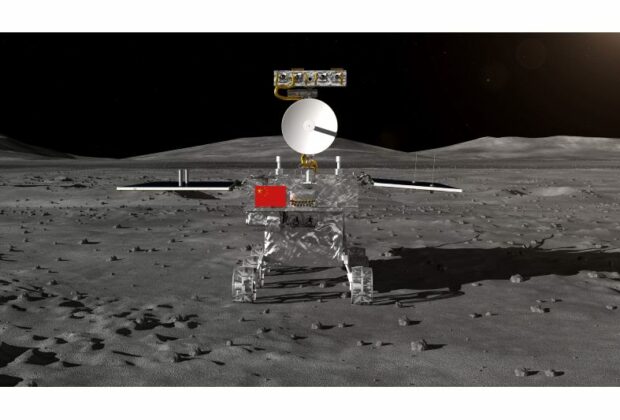China has successfully recovered over two kilograms of lunar material from the moon’s far side, preparing it for upcoming deep space missions.
On June 25, the Chang’e-6 reentry capsule made a successful return to Earth, capping out a 53-day mission. The anticipated recovery of the capsule took place in the plains of Inner Mongolia’s Siziwang Banner.
After being transported to Beijing, the capsule was opened on June 26 in order to extract the sample canister. On Friday, the China National Space Administration (CNSA) declared that 1,935.3 grams of material were included.
The mission’s goal was to gather up to two thousand grams. 1,731 grams were gathered by the Chang’e-5 near-side mission in 2020. Drilling problems that were encountered during that mission affected the quantity collected.
The sample container will then be opened by the Chinese Academy of Sciences’ National Astronomical Observatories. After that, NAOC will pack and prepare the samples it has collected through drilling and surface retrieval for storage.
After six months, applications for samples are anticipated to be accepted from domestic scientific research institutions. Two years later, samples will be made available for use in other countries in accordance with CNSA guidelines for managing lunar samples.
Spokesman for the CNSA Ge Ping said that compared to earlier lunar samples, these ones are stickier and more compressed.
Mysteries of the South Pole-Aitken
The samples are expected to “address questions about the multiple lunar nearside–far side dichotomies and to provide new insights into both the early impact history of the Solar System and the geological evolution of the moon,” according to a 2023 paper on the potential landing spot.
Li Chunlai, deputy chief designer of the Chang’e-6 mission, stated at a press conference in Beijing on June 27 that “the samples collected from the South Pole-Aitken Basin may be very different from the samples collected from the front side, which is conducive to a more comprehensive understanding of the geological evolution history of the moon.”
It remains to be seen how revealing the samples will be. “There is no question that new insights into the nature of the moon’s evolution will be provided by the return of the far side samples. And the fact that they have just successfully touched down on Earth is a tremendous accomplishment for China,” University of Notre Dame professor and lunar scientist Clive Neal told.
Nonetheless, Neal points out that the landing spot is among the moon’s oldest terranes. Therefore, it is expected that later geologic processing may dilute, obfuscate, and disperse debris from the South Pole-Aitken basin impact—a large basin formed by a massive, ancient impact that is of significant scientific importance.
“Whether they will unequivocally demonstrate the age of the South Pole Aitken basin or define the first mantle sample returned from the moon remains to be seen, but these samples will reveal secrets in the coming decades, just as the Apollo samples have done.”
Upcoming Deep Space Missions
The second Tianwen mission, according to CNSA officials, is scheduled to launch in 2025. Tianwen-2 is a combined comet rendezvous and asteroid sample return mission. As of right now, May 2025, a Long March 3B rocket is supposed to launch it.
After launching, the mission will return to Earth around 2.5 years later with samples taken from the near-Earth asteroid 469219 KamoŻoalewa. After delivering samples, the spacecraft will target comet 311P/PANSTARRS in the main belt.
The fact that the third and fourth Tianwen missions will launch around 2030 was also reaffirmed. These are the Tianwen-4 Jupiter mission and the Tianwen-3 Mars sample return. Currently, the latter will consist of a smaller spacecraft that will fly by Uranus and a solar-powered Jupiter orbiter.
China will also carry out significant national scientific and technology initiatives and programs in the aerospace industry, according to Bian Zhigang, the deputy administrator of the CNSA. Heavy-lift launchers and reusable spacecraft are two examples of these. Furthermore, China wants to boost fundamental research, quicken the development of important core technologies, and encourage creative advancements in space science, space technology, and space applications.
Upcoming Lunar Missions, Collaboration
China is now gearing up for the Chang’e-7 lunar south pole mission, which is anticipated to focus on Shackleton crater. The Queqiao-2 relay satellite, which made the Chang’e-6 mission possible, will support it.
In late 2023, CNSA released a call for applications for the Chang’e-8 lunar south pole mission scheduled for 2028. The payload capacity for international collaboration is 200 kg. On Thursday, CNSA said that it had received over thirty letters of intent to work together on the mission.
When asked about collaboration with the US, Bian stated that the US should eliminate obstacles. In particular, he brought up the so-called Wolf Amendment.
“If the U.S. side sincerely hopes to carry out normal space exchanges with China, it must take practical measures to remove the obstacles. As for China’s future space plans, they will be carried out at China’s own pace for peaceful use. We’re always eager to develop equal and mutually beneficial cooperation in an open and inclusive attitude,” Bian stated.








